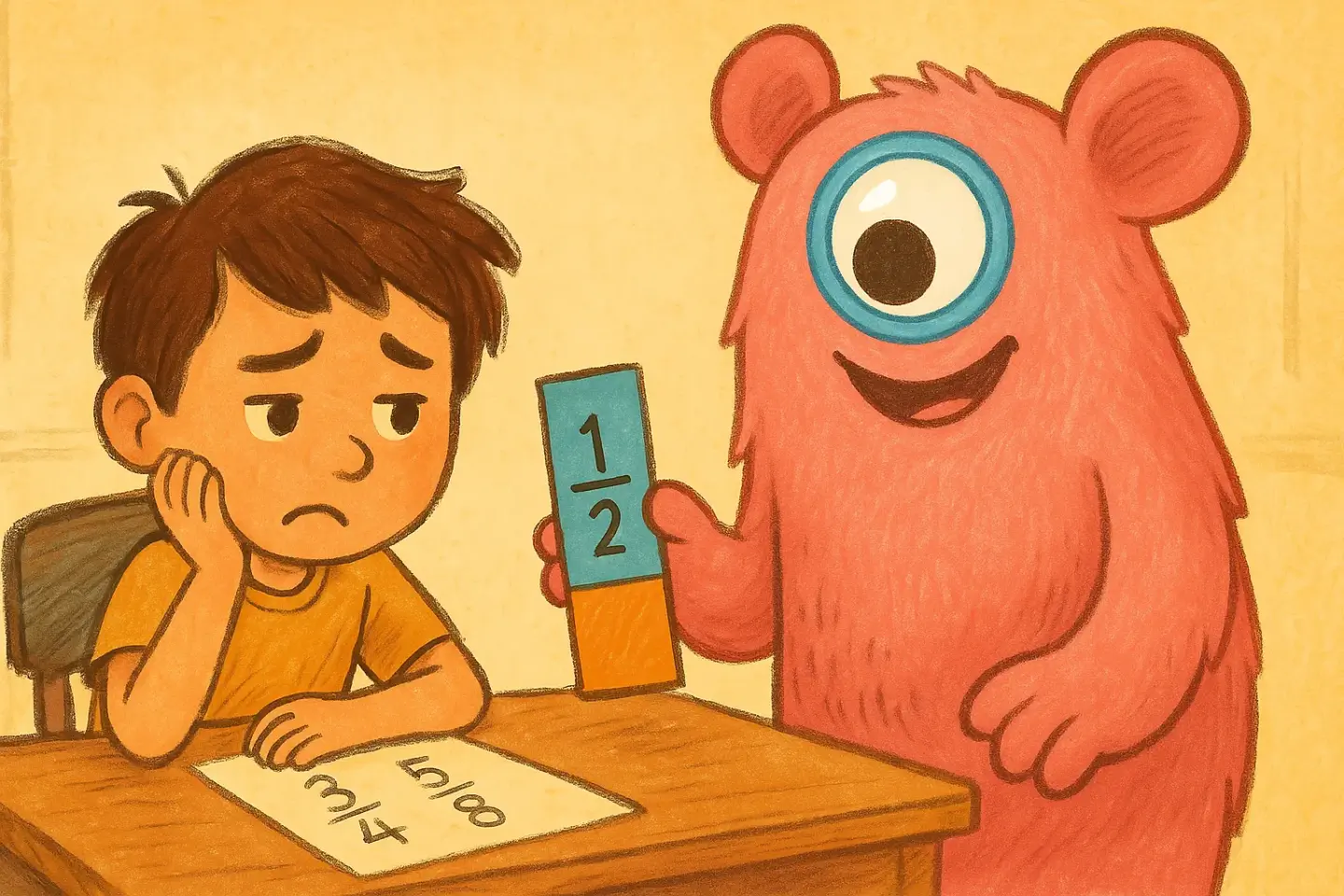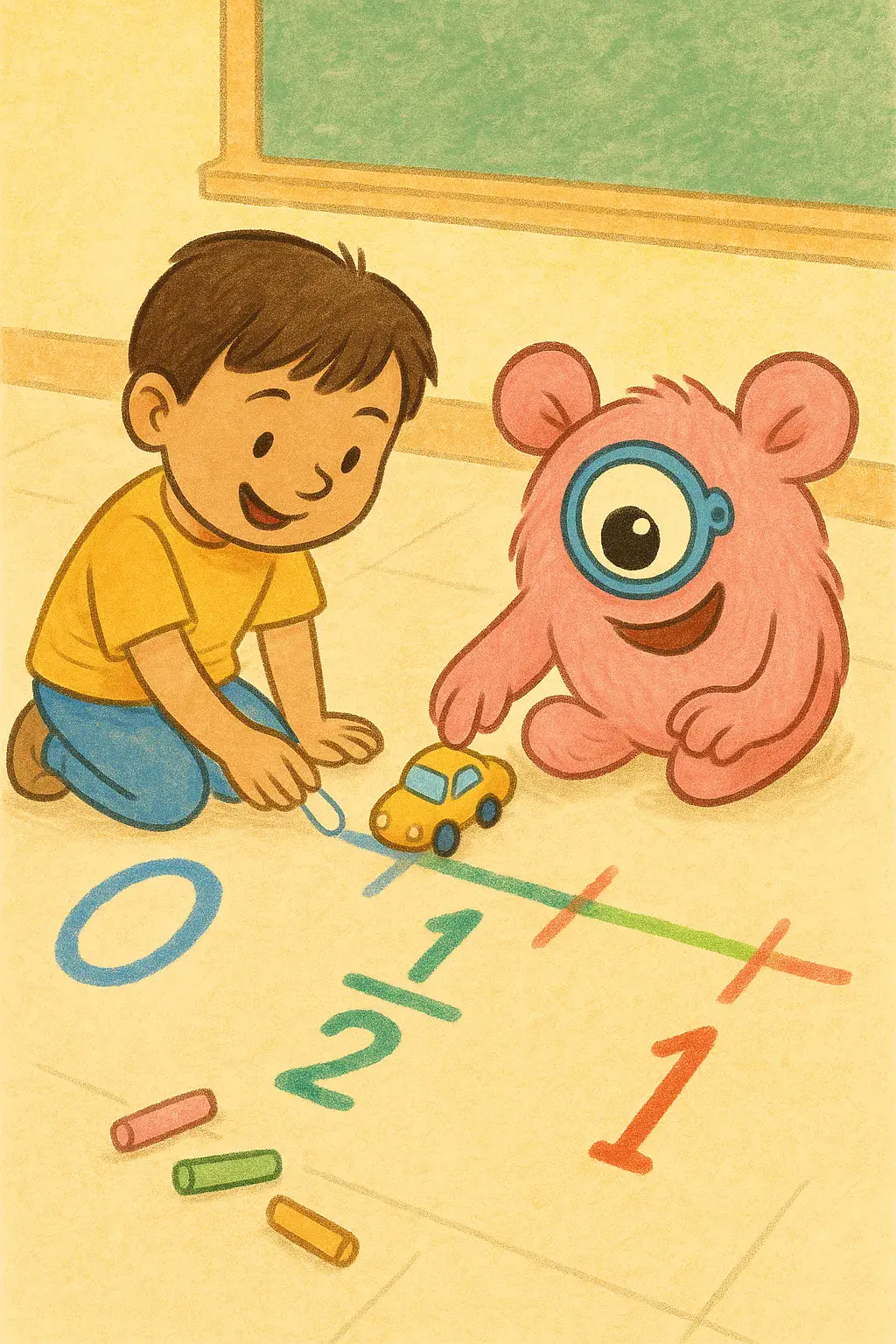Teaching Fractions to Children with Dyscalculia: A Parent's and Teacher's Guide
Why fractions are a unique hurdle for neurodiverse learners and how to build a bridge to understanding.
TL;DR: Teaching fractions to children with dyscalculia is uniquely challenging because it combines their core difficulties: poor number sense, working memory limits, and abstract thinking. Standard methods often fail. The most effective, research-backed strategies are:
- Start with concrete, hands-on objects (like food or blocks) before moving to drawings or symbols (the C-R-A method).
- Focus on magnitude and estimation. Use a number line constantly to help them "see" where a fraction lives (e.g., "Is 1/8 closer to 0 or 1?").
- Use clear, consistent language. "One-fourth" is better than "1 out of 4."
- Prioritize conceptual understanding over rote memorization of procedures.
Let's be honest: the word "fractions" can make even adults feel a little anxious. For a child with dyscalculia, that anxiety can be a full-blown barrier to learning. If you're a parent or teacher, you've likely seen the look—the confusion when `1/2` and `1/4` are presented, the frustration when "equivalent" fractions seem like a magic trick, and the shutdown when asked to add `1/3 + 1/4`.
You are not alone, and your child's struggle is not about a lack of effort. Fractions represent a massive cognitive leap, and for learners with dyscalculia, they target every single area of difficulty. But here's the good news: with the right strategies, progress is absolutely possible. This article will explore *why* fractions are such a high hurdle and provide practical, research-backed ways to help.

Why Fractions Feel Impossible for Learners with Dyscalculia
To a child with dyscalculia, a fraction like `3/4` isn't one number. It looks like two separate whole numbers, 3 and 4, stacked on top of each other. This creates immediate confusion. Their core challenges with "number sense" make it incredibly difficult to understand that `3/4` is a single quantity—a value that is more than `1/2` but less than 1.
Research consistently shows that learners with dyscalculia struggle with processing magnitude, or the "bigness" of a number (Mazzocco, 2011). This is the fundamental skill of knowing that 9 is more than 5 without counting. When applied to fractions, this deficit is magnified. They struggle to see that `1/8` is *smaller* than `1/4`, because 8 is bigger than 4.
This is compounded by other common traits of dyscalculia:
- Weak Part-Whole Understanding: The very concept of a "whole" being broken into "parts" can be abstract. They may struggle to keep the "whole" in mind, especially if it changes from one problem to the next (e.g., the "whole" is a pizza, now it's a group of 12 marbles).
- Working Memory Overload: A single fraction problem requires a student to juggle multiple pieces of information: the numerator, the denominator, the operation, and the relationship between them. This cognitive load is often too much for a child with working memory deficits (Geary, 2011).
- Poor Visual-Spatial Skills: While we think of pie charts as helpful, they can be confusing. A dyscalculic learner may struggle to visually compare the area of `1/6` of a circle to `1/5` of a circle (Rousselle & Nöel, 2007).
As we explore solutions, it's helpful to remember these underlying challenges. We aren't just teaching a math topic; we're building a new way of thinking about numbers.
For more on the foundational signs, see our related article: Signs your child may have Dyscalculia.
Effective Strategies: Building Fractions from the Ground Up
The golden rule is: go slow to go fast. Rushing to abstract symbols and rules is a guaranteed path to frustration. We must build a solid, concrete foundation first.
1. Use the C-R-A (Concrete-Representational-Abstract) Method
This is the cornerstone of effective math intervention. You must progress through these three stages in order, and do not leave the 'Concrete' stage until your child has shown mastery.
- Concrete: Use real, tangible objects. This is non-negotiable.
- Food: Cut a sandwich into two equal halves. Share a chocolate bar with four equal squares. "You get one-fourth. I get one-fourth." Use food for "fair sharing" concepts.
- Manipulatives: LEGO bricks are fantastic. A 2x4 brick can be the "whole." Two 2x2 bricks are "halves." Four 2x1 bricks are "fourths."
- Fraction Tiles/Bars: These are a must-have. They are better than pie charts because they are easier to compare and line up.
- Representational (Visual): Once they master the concrete, move to drawing.
- Draw the sandwich, the chocolate bar, the LEGOs.
- Use "area models" (rectangles are often clearer than circles).
- Introduce the number line here (more on that next).
- Abstract: Only after mastering the first two stages do you introduce the symbols: `1/2`, `1/4`, `3/4`. The child now has a mental image and a physical memory to connect to these abstract numbers.
2. Make the Number Line Your Best Friend
If you take away only one strategy, let it be this one. For all learners, but *especially* those with math difficulties, the number line is the most powerful tool for teaching fractions (Siegler et al., 2011). Why? Because it builds on their existing (though perhaps weak) knowledge of whole numbers and reinforces that fractions are, in fact, numbers. They have a specific value and location.
Start with a simple 0-1 number line.
- "Where does 1/2 live? Exactly in the middle."
- "What about 1/4? It's halfway between 0 and 1/2."
- "Let's find 3/4. Is it closer to 0 or 1?"

This emphasis on estimation and magnitude is far more important than exact calculations at first. This approach directly targets the core "number sense" deficit (Jordan & Hansen, 2018).
It also helps reduce anxiety by focusing on understanding ("what's it near?") rather than a single right/wrong answer.
3. Focus on Language and Vocabulary
The language we use matters.
- Say "one-fourth" or "one-half", not "one over four" or "one out of two." This reinforces the fraction as a single unit (a "fourth").
- Explicitly teach vocabulary. Don't assume they know "numerator" or "denominator." Teach them: "The denominator (down) tells us the *name* or *size* of the pieces. The numerator (up) tells us *how many* of those pieces we have."
- Talk about "fair shares." This is language they understand. "If we share one pizza fairly among 8 friends, does everyone get a big piece or a small piece?" This helps them intuitively grasp that as the denominator gets bigger, the piece gets smaller (Lortie-Forgues et al., 2015).
4. Go Deep on One Fraction at a Time
Don't introduce halves, thirds, and fourths all in one day. Spend days or even a week just on "halves." Find halves of everything: half a cookie, half a piece of paper, half a group of 10 toys, half-way to the door. Only when they truly, deeply understand "half" in many contexts should you move on to "fourths" (which are just halves of halves). Then move to "thirds."
Patience, Persistence, and Progress
Teaching fractions to a child with dyscalculia is a marathon, not a sprint. There will be days when they seem to "get it" and days when the knowledge seems to have vanished. This is a hallmark of dyscalculia, tied to working memory and retrieval challenges. It is not their fault.
Your role is to be a patient, consistent guide. Celebrate small victories. "Yes! You knew that 3/4 was more than 1/2!" This focus on "fraction sense" is the ultimate goal. The ability to estimate and understand the magnitude of fractions is what will predict their future math success—far more than their ability to mechanically find a common denominator (Siegler et al., 2012).
By using concrete tools, focusing on the number line, and using clear language, you are giving them the cognitive tools they need to build a bridge from confusion to comprehension.
Frequently Asked Questions (FAQs)
Q: What's the biggest mistake to avoid when teaching fractions?
A: Rushing to the abstract symbols (`1/2`) and algorithms (like adding/subtracting). This is like teaching a child to read by giving them a rulebook on grammar before they know any words. For a dyscalculic learner, this is a path to failure. Always start concrete.
Q: Are computer games or apps good for teaching fractions?
A: They can be, but you must be selective. Avoid games that are just timed drills (e.g., "click the right answer"). Look for apps that heavily feature visual models, especially the number line, and allow for exploration without time pressure. Games that involve estimation ("Move the slider to where 2/3 should be") can be very effective.
Q: Why are fraction circles/pies less effective than fraction bars/strips?
A: While pies are popular, research suggests they are harder for children to use. It's visually difficult to compare `1/5` of a circle to `1/6` of a circle. Fraction bars or strips, however, can be lined up side-by-side, making it much easier to compare lengths, see which is larger, and physically build "equivalent" fractions (e.g., seeing that one `1/2` bar is the exact same length as two `1/4` bars).
Q: My child just can't remember the "rules" for adding fractions. What do I do?
A: Stop focusing on the rules and go back to understanding. Get out the fraction bars. Ask them to *show* you `1/2 + 1/4`. They will physically take the `1/2` bar and the `1/4` bar, place them end-to-end, and then try to find a single bar (or combination of bars) that matches that new length. They will discover it's the `3/4` bar. This *physical understanding* must come long before the abstract rule of "find a common denominator."
References
- Mazzocco, M. M. M. (2011). The development of the number system. In S. Dehaene & E. Brannon (Eds.).
- Geary, D. C. (2011). Cognitive predictors of difficulty with fractions..
- Rousselle, L., & Noël, M. P. (2007). Basic numerical skills in children with mathematical learning disabilities (dyscalculia). .
- Siegler, R. S., Thompson, C. A., & Schneider, M. (2011). An integrated theory of whole number and fractions development. .
- Jordan, N. C., & Hansen, N. (2018). The role of number sense in children's understanding of fractions.
- Lortie-Forgues, H., Tian, J, & Siegler R. S. (2015). Why is learning fractions so difficult? A processing constraints approach. .
- Booth, J. L., & Newton, K. J. (2012). Fractions: Could they really be the gatekeeper’s doorman?
- Siegler, R. S., Duncan, G. J., Davis-Kean, P. E., Duckworth, K., Claessens, A., Engel, M., ... & Chen, M. (2012). Early predictors of high school mathematics achievement.
- Gersten, R., Chard, D. J., Jayanthi, M., Baker, S. K., & Morphy, P. (2009). Mathematics instruction for students with learning disabilities: A meta-analysis of instructional components.
- Hecht, S. A., & Vagi, K. J. (2010). Sources of group and individual differences in emerging fraction skills.
- Ramani, G. B., & Siegler, R. S. (2011). Reducing the gap in numerical knowledge: Using linear board games to promote low-income preschoolers' numerical knowledge.
